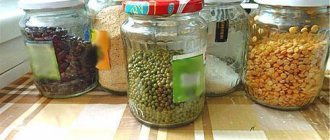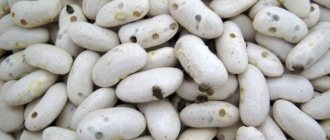Every housewife has cereals in her kitchen, since porridge is a valuable source of carbohydrates and other nutrients. They can be stored for a long time, but if the conditions are not met, they quickly lose their consumer qualities. And it’s not just the formation of mold or the appearance of an unpleasant odor. Such products often harbor pests. Moreover, this cannot be detected immediately. To ensure that cooked porridge always turns out tasty, you need to know how to properly store cereals. To prevent bugs from appearing and an unpleasant odor to appear, you must follow some rules.
How to choose cereal
There are many insects that spoil food supplies. Therefore, special conditions are required for storing cereals. If they are not followed, pests may appear or an unpleasant odor may appear. Moreover, this happens not only at home. Not all grocery stores know how to store cereals correctly. Therefore, you can bring pests home when purchasing.
To avoid this, you need to carefully inspect the products, especially when purchasing cereals and flour:
- If they are in a box or non-transparent bag, you need to check the expiration date. It is better if they are packaged no earlier than 2-4 months in advance. The box must be hermetically sealed.
- You also need to check whether the store’s storage conditions for cereals are met. There should not be high humidity or high temperature.
- It is easier to check the quality of a product that is packaged in a transparent bag or sold by weight. You can check for lumps, bad odors, blackheads or insects.
- A large amount of dust, garbage or flour is also an indicator of poor quality of the product.
But even if all conditions are met in a store or warehouse, this does not always protect products from the proliferation of pests.
Is it possible to use the product if the permissible period of its use has expired?
Signs that the cereal is spoiled are as follows:
- feeling of musty smell;
- white plaque and mold are visible;
- pests appear, their larvae are eaten, cobwebs are encountered;
- the grains stick together into hard lumps;
- unpleasant smell when cooking.
This product should not be used as food and must be thrown away. Cereals belong to the category of products, when consuming which you should clearly focus on the permissible shelf life. To store these products, the conditions must be strictly observed. If signs of cereal unsuitability appear, then it is not allowed to be eaten.
If you find an error, please select a piece of text and press Ctrl+Enter.
Recommendations for proper storage of cereals
Insects not only spoil the product. They leave behind waste products that make the cereal unsuitable and even dangerous to health. In addition, the taste of the product changes. After purchasing, many housewives recommend immediately sorting out the cereal. But the presence of insect larvae is not always noticeable. Therefore, there are several ways to prevent their reproduction.
- Fry the purchased cereal in the oven or heat it in a frying pan without oil. This does not reduce the quality of the product, sometimes even improves the taste, but is guaranteed to destroy the larvae.
- You can put the cereal in the freezer for a couple of days. In winter, a balcony is suitable for this.
- A small amount can be heated in the microwave. 5 minutes is enough to destroy pests.
It is recommended to regularly check cereal containers for insects. If they are found, the spoiled product must be thrown away. It is recommended to rinse the container well with baking soda or pour boiling water over it. And wipe the cabinets with vinegar.
Previously, housewives knew how to store cereals in the kitchen to prevent the proliferation of pests. There are several secrets:
- You need to put a few bay leaves at the bottom of the container with cereal;
- Place a few cloves of garlic inside;
- salt also protects against insects - a gauze bag with coarse salt is placed in a container;
- place a pod of hot pepper in a container with rice;
- Place a lemon peel or a piece of mint gum on top of the cereal.
Secret sliding panel
It is not necessary to put your culinary supplies on public display - they can be disguised. For example, by building a retractable shelf into a kitchen set, which will look like an ordinary decorative panel.
This method is quite unusual, but requires significant costs: you will have to purchase a custom-made kitchen. However, the final result is worth it - few people can hold back an exclamation of surprise when they see how you take out pasta or seasonings for it from the seemingly solid wall of the set.
Storage conditions for cereals
To prevent bugs from infesting and for the cereal to remain healthy for a long time, certain conditions must be observed. They will help prevent the appearance of lumps, mold, odors, and pests.
- First of all, you need to know at what temperature cereals should be stored. The optimal temperature is no higher than 100. But this is not always possible, so it is advisable that it does not exceed 200.
- Air humidity should be no more than 70%.
- Products should not be exposed to sunlight.
Properly storing cereals at home is not difficult, you just need to choose a container. It is not recommended to leave them in their original packaging or in a plastic bag. It is better to store cereals in a special container. In addition, it is important to find a place where conditions for storing cereals and flour are met. And you definitely need to take into account expiration dates.
Rack with pull-out shelves
A small narrow cabinet with pull-out shelves will also look original. You can see these in the supermarket. Make several large drawers for cereals and pasta, a couple of smaller ones for coffee and tea, and very tiny ones for spices.
Such a cabinet, especially if it is designed to match a kitchen set, will look organic. Pull-out shelves make it easier to find the products you need and organize the arrangement of products.
If you are not a fan of large stocks, you can make such a rack in the form of a small decorative cabinet placed on the kitchen panel or built into the set. In any case, such shelves are convenient and easy to implement.
Where to store cereals
To learn how to store cereals at home correctly, you need to choose a place. Where is the best place to store flour, cereals and other bulk products? The most optimal conditions are a dry, dark, cool place. It's good if the house has a storage room. But a cellar or basement is not suitable, as there is high humidity there.
Sometimes it is recommended to store cereals in the refrigerator, but this is also not the best option. It will take up a lot of space there, and it will be difficult to protect it from moisture. Therefore, the refrigerator can be used only if there is no other choice, for example, you need to protect food from rodents at the dacha.
But most housewives prefer storing cereals in the kitchen. How to choose the right place there? You need to find the cabinet furthest from the stove and radiator and allocate the bottom shelf for these products. There is the most optimal temperature, there is no sunlight or humidity, because steam and warm air always rise upward. But it is unacceptable to use shelves above the sink.
Hanging shelves for refrigerator
If you have easy access to the side wall of the refrigerator, a wall-mounted structure that can accommodate sealed jars for bulk products can be a great solution for a small kitchen.
This way they won’t take up precious space on the shelves, but will always be in order and in sight. This method is a kind of organizer that will greatly facilitate the search for the necessary ingredients for cooking.
Tip: For a white refrigerator, choose shelves that match the color scheme in the kitchen. If you bought a more original colored unit, choose a suspended structure in a contrasting shade.
What is the best way to store cereals: containers, dishes or bags
After the cereal has been checked for pests and the place where it will be stored has been chosen, you need to find in which container to place it. The container is a must. It is unacceptable to store cereals in factory packaging. Once opened, pests and moisture easily penetrate it. Is it possible to store cereals in a plastic bag? This is also not a suitable container for them. The bag develops a musty odor and mold may appear. In addition, such packaging is fragile and breaks quickly.
Previously, housewives made bags for storing cereals with their own hands. They were made of natural fabric - cotton or linen. They were soaked in a strong saline solution and dried. Salt protects the product from insects and unpleasant odors.
Nowadays, dishware manufacturers produce special sets for storing bulk products and cereals. Each housewife can choose how to store cereals in the kitchen. You can purchase the same containers for all products or different ones.
This depends not only on the preferences of the hostess or the features of the interior. It is necessary to consider what material the kits for these products are made of so that they can create optimal conditions. Therefore, you need to know what is the best way to store flour or cereals.
- Most often it is recommended to store cereals in glass jars. The main thing is that they have hermetically sealed lids. It is best to purchase special containers. They have a convenient rectangular shape, so they take up less space. But you can use glass canned jars to store cereals. The main thing is to wash and dry them well.
- You can also store cereals and flour in plastic containers. They are lightweight, easy to clean, and take up little space on the shelf. On sale you can find plastic jars for storing cereals of various shapes and sizes.
- What other containers are recommended for storing bulk products? Ceramic jars with tight-fitting lids work well for this. They can decorate any interior.
- But metal is not suitable for bulk products. Such containers quickly rust.
Paint the lids of glass jars one color. This way you will create a set of different shapes and sizes that will look beautiful on the shelf and provide convenient use.
Magnetic board
This storage method is more suitable for spices - after all, large containers will look a little strange, and placing small containers on the board is much easier.
The essence of the technique is quite simple: a canvas with magnetic properties is attached to the wall in a convenient place. Then small jars with metal lids or magnets on the walls are selected. Then everything is simple: attach them in a random or strictly defined order, depending on your taste.
It is not necessary to purchase special containers for this. Clean jars of tick-tock dragees, signed in a beautiful font, look original. Just attach a ribbon with a message on one part and a small magnet on the other.
For a large kitchen: If you want to use this technique for cereals, you will need a lot of space, a magnetic board and more powerful magnets. Select containers that are not too heavy and think about the location so that it is convenient for you to reach each jar.
How long can cereals be stored?
Different products have different expiration dates. It is believed that cereals can be stored for a long time - up to 2-3 years. But this shelf life is only suitable for rice, especially long-grain varieties. Other species lose their consumer qualities earlier. Processed grains have the shortest shelf life: flakes and ready-made cereals. And millet quickly acquires an unpleasant odor and bitterness.
It is important to know how long you can store semolina at home. It also deteriorates quickly and can absorb odors. Once opened, it is good for no more than 9 months. Oats, pearl barley, buckwheat and peas are stored the longest. But this is only subject to acceptable conditions.
| Groats | Best before date |
| Semolina | 10 months |
| Corn grits | 10 months |
| Millet polished groats | 9 months |
| Oat groats | 10 months |
| Buckwheat (kernel) | 20 months |
| Buckwheat (done) | 18 months |
| Pearl barley | 18 months |
| Barley grits | 15 months |
| Wheat groats | 14 months |
| Polished rice | 18 months |
| Broken rice | 16 months |
| Peas, shelled | 24 months |
| Split peas | 20 months |
| Cereals | 4 months |
| Oatmeal | 4 months |
What determines the shelf life?
The shelf life and storage of cereals depend on the type . Each has a different composition. The consumer should be aware that different cereals have different fat contents. The duration of storage depends on this indicator. For example, there is so much fat in oatmeal that you don’t need to add oil to the porridge. Buckwheat has the lowest fat content. Accordingly, oatmeal is stored for no more than four months, and buckwheat has a shelf life of up to one and a half years.
Different regions have different deadlines. This is due to climatic conditions.
Cereals are produced:
- whole grains;
- in crushed form;
- in pressed form.
In addition, they can be offered to the consumer in the form of mixtures. For example, the “Three Grains” porridge mixture. Manufacturers offer cereals at various stages of processing and with the addition of various ingredients.
The deeper the processing stage, the shorter the shelf life.
Transparent and opaque jars
Transparent materials allow you to see the products that are inside. However, they are not able to protect the contents from sunlight, so it is recommended to store transparent dishes in a closed cabinet in the dark.
Opaque jars reliably protect cereals from the sun's rays and look more impressive due to their beautiful design, drawings and inscriptions. There are models in which, instead of inscriptions, transparent windows , allowing you to see the contents without opening the lid.











